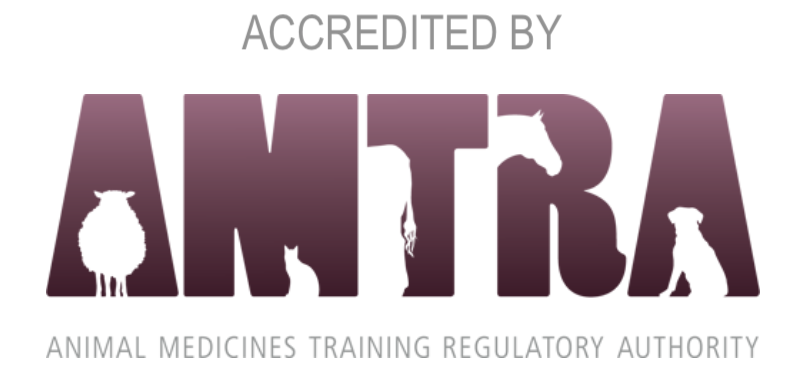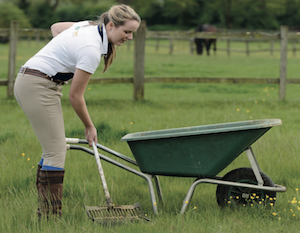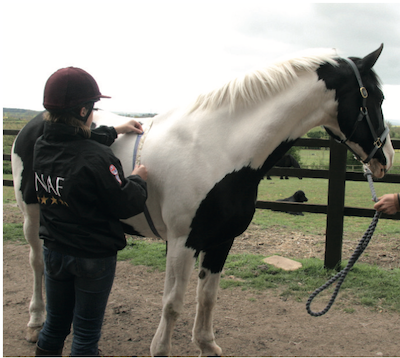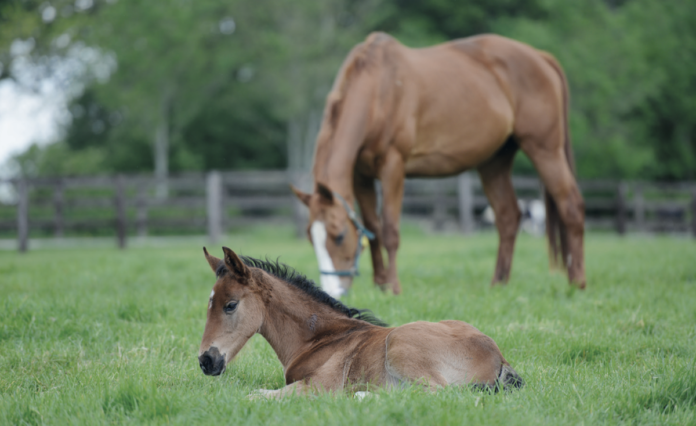Autumn and winter worm control – what your customers need to know
Dr Wendy Talbot, National Equine Veterinary Manager at Zoetis

All RAMAs/SQPs must earn a certain number of CPD points in a given period of time in order to retain their qualification. RAMAs/SQPs who read this feature and submit correct answers to the questions below will receive two CPD points.
Worm control is a foundation block for good horse health and performance and, whether a vet or a Registered Animal Medicines Advisor (RAMA), we have a duty to help horse owners make the right choices about worming.
Talking about worm control may not be quite as exciting as chatting about tack or riding kit, but explaining your role as a RAMA can help open the door to the less enthusiastic customer. You have worked hard to obtain and retain your qualification as a highly knowledgeable advisor and prescriber of wormers; making your customers aware of your expertise is likely to make them more receptive to what you have to say.
COUNTDOWN TO WINTER
Parasite life cycles are linked to the seasons, which is why one of the first rules of worm control is to take into account the time of year. The summer months present the ideal environmental conditions for the development of eggs and larvae on the pasture. This can lead to high pasture contamination and increase the potential for horses to acquire new parasite burdens, predominantly small redworms, and this Is why regular faecal worm egg counts (FWECs) every 8-12 weeks from March to October, are so important.1
Eggs per gram
Treatment is usually recommended if there are greater than 200 eggs per gram (> 200epg).1 The exact timing of further FWECs is determined by a number of factors including the egg count detected, the age and circumstances of the horse and the wormer last used for treatment.2 For example, for a horse with previously high egg counts further tests at 8 weeks may be recommended; whereas a horse with consistently low counts, good pasture management and no signs of disease would be more likely to need testing every 12 weeks.
It is important to remember that even if a horse has a FWEC < 200epg, if it is showing any signs which may be related to a worm burden it should be evaluated by a vet to determine if a treatment is required.2,3
Autumn and winter priorities
At this time of year most parasites are entering a less active phase and by winter the potential for further pasture contamination is reduced. However, encysted small redworm, tapeworm and bots will need special attention during this time.
ESRW: Key points for your customers
- During the autumn, the larval stages of the small redworm can stop developing inside the horse’s gut and enter a type of hibernating state known as encysted small redworm (ESRW).3
- Large numbers of encysted small redworm larvae can be present and because larval stages do not produce eggs, they cannot be tested for using faecal worm egg counts. However, a vet can carry out a specific blood test which can show if encysted small redworm are likely to be present.3
- Large burdens of encysted small redworm can cause a condition known as larval cyathostominosis when they emerge from their hibernating state. The resulting diarrhoea, colic, and severe weight loss can be fatal, especially in young horses. This typically happens in the spring but in some cases can occur earlier in the winter period.3
- All horses of more than six months of age should be blood tested or dosed with a wormer that will treat for encysted small redworm in autumn/winter, regardless of their FWEC.4
- Moxidectin is the only active ingredient licensed to treat encysted small redworm in a single dose.
- A five-day course of fenbendazole is also licensed to treat encysted small redworm but there is widespread evidence of small redworm resistance to fenbendazole, including the five-day dose so a resistance test is recommended before using it.3
- Treating with a wormer that does not specifically target the encysted stages (ivermectin, pyrantel or single dose fenbendazole) during late autumn and winter can actually increase the risk of a horse with a high ESRW burden developing larval cyathostominosis.5
Tapeworm: key points for your customers
- In the UK the highest burdens of tapeworm are seen at the end of the grazing season.5
- They can result in a number of health-related problems, ranging from loss of condition to diarrhoea and colic. An infected horse has been shown to be 26 times more likely to develop colic associated with an obstruction of part of the small intestine (ileal impaction colic) than a non-infected horse, and eight times more likely to experience a type of cramping of the intestine resulting in spasmodic colic.6
- To control tapeworm horses should be dosed with praziquantel in a combination wormer or a double dose of pyrantel at six-monthly intervals usually spring and autumn.6 Alternatively, a blood or saliva test can be carried out to establish antibody levels.7
Bots: key points for your customers
- The female bot fly is a prolific egg layer. She can produce up to 1,000 distinctive yellow eggs on the hair on the horse’s legs and shoulders or around the eyes, mouth and nose.
- Horses can inadvertently ingest the bot eggs while grooming themselves or a companion. The bot larvae will mature in the horse’s mouth and develop in the stomach over winter before emerging in the spring or summer via dung. The larvae then burrow into the ground and develop into adults. Depending on the conditions, the adults emerge one to two months later and the cycle begins again.5
- The best way to control bots is to administer a suitable wormer in the winter, after the first frost when the adult flies have died and before the bots mature.8
- The correct worming protocol will not only help to safeguard the health of the individual horse but will also have an impact in reducing the bot fly population in the area.
- A practical and cost-effective solution may be to combine a bots treatment with ESRW and tapeworm treatments using a single dose of moxidectin and praziquantel.
DOSING FOR OTHER WORMS
Large redworm, although uncommon, can be a re-emerging problem in some populations, especially where wormers are not used for prolonged periods of time. For most horses these parasites should be adequately addressed incidentally within a worming programme for small redworm by the administration of either moxidectin or ivermectin once or twice a year.8
Pinworm, liver fluke and lungworm may be a concern for some horses – remember to mention these to your customers to see if their horses may be at risk.5
Foals and young horses are more susceptible to worm-related disease and the parasites can differ from those of adult horses. Foals require treatment for ascarids twice in the first 6 months of life (at 2-3 months of age and then again at 5-6 months of age) and careful, frequent monitoring and treatment for redworm from 6 months to 3 years old.5,9,10
GOOD WORM CONTROL INVOLVES MORE THAN JUST WORMING
Paddock management

Poo picking, ideally every day, will reduce the overall worm burden and thus the need for excessive use of wormers. Some of your customers may be in a position to create smaller paddocks so that each field can be alternately grazed, harrowed and rested. Harrowing is not recommended in wet weather conditions because eggs and larvae are only effectively killed in dry hot weather. Paddocks should have low numbers of horses per acre to reduce the burden on the field. Cross-grazing with sheep and cattle is also effective at reducing horse parasite burdens on the pasture as they will ‘hoover up’ the worms without being affected. In some areas, liver fluke may be a concern for horses co-grazing with cattle and sheep.10
History
It’s a good idea to encourage your customers to keep thorough records so that they have a history of the wormers used and the results of tests for the whole year and not just from the last wormer. They can share this information with you or their vet to make sure the correct parasite threat has been targeted at the correct time and to avoid overuse of the same types of wormer.
Faecal egg count reduction tests
Faecal egg count reduction tests (FECRTs) are useful to check that wormers are working properly. The test involves taking an FWEC immediately before and two weeks after worming to assess how effectively the wormer has reduced the level of worm eggs being shed. The results can indicate if there may be resistance developing to the active in that wormer.8

Weight matters
In addition, horses should always be weighed before worming for accurate dosing. Establishing a horse's weight by guessing and not using a weigh tape or weigh bridge, means risking giving the horse an overdose or insufficient dose of wormer. It’s particularly easy to under-estimate the weight of our horses, which can result in under-dosing and contribute to resistance.3
New yard members
New horses should be introduced to the yard carefully: A new horse could bring the unwelcome addition of high levels of worms, with the extra problem that these may be worms that are resistant to some of the worming treatments currently available. This means they may be tougher to get rid of and they could cause ongoing problems for the entire yard. Remind your customers to test any new horses and treat them accordingly and then keep them in for at least 48 hours to avoid contaminating grazing.
References
- Rendle D (2017) De-worming targeted plans. Vet Times, Equine, Vol.3 Issue 1 p16-18
- Hallowell- Evans C and Hallowell G (2017) Vet Times, April 24
- Matthews JB (2008) Equine Vet Educ, p 552-560
- Austin Davis Biologics Ltd. Small Redworm Blood Test Press Release. https://www.austindavis.co.uk/small-redworm-blood-test. Accessed 11th October 2019
- Reinmeyer CR and Neilsen MK (2018) Handbook of Equine Parasite Control. 2nd ed. Hoboken, NJ: John Wiley & Sons.
- Proudman CJ (2003) Journal of Equine Veterinary Science 23 (1) 6-9
- Austin Davis Biologics Ltd: Elisa Kits. https://www.austindavis.co.uk/elisa-kits. Accessed 8th April 2020
- AAEP (2019) Parasite Control Guidelines
- Nielsen (2016) Evidence-based considerations for control of Parascaris spp. infections in horses. Equine vet. Educ. 28 (4) 224-231
- Matthews JB (2017) Helminth control programmes for equine yearlings at pasture. Veterinary Times; 47(8):22-22, 24.
ETN’s series of CPD features helps RAMAs (Registered Animal Medicines Advisors/SQPs) earn the CPD (continuing professional development) points they need. The features are accredited by AMTRA, and highlight some of the most important subject areas for RAMAs/SQPs specialising in equine and companion animal medicine.

AMTRA is required by the Veterinary Medicines Regulations to ensure its RAMAs/SQPs undertake CPD. All RAMAs/SQPs must earn a certain number of CPD points in a given period of time in order to retain their qualification. RAMAs/SQPs who read this feature and submit correct answers to the questions below will receive two CPD points. For more about AMTRA and becoming a RAMA/SQP, visit www.amtra.org.uk











